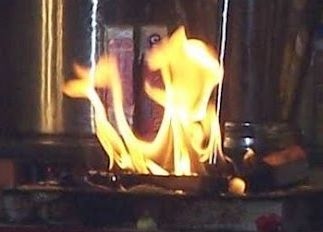Puja
Ahnika manuals
- [ link ] gāyatrī-śiṣṭārtha-mālā (see publications page)
- [ link ] sandhyāvandana bhāṣya by sītārāma śāstrī
- [ link ] sandhyā bhāṣya samuccaya by vināyaka gaṇeśa āpṭe
- [ link ] āhnika candrikā – daily rituals with ṛg veda mantras
- [ link ] sāma vedīya nityāhnikam – daily rituals with sāma veda mantras
- [ link ] brahma karma samuccaya – daily rituals and ṛg veda saṁskāras
- [ link ] smṛti muktā phala - varṇāśrama kāṇḍa
- [ link ] ahnika manuals by Narasimha Rao
Devi Mahatmyam
- [ link ] gītā press edition (sanskrit & hindi)
- [ link ] gītā press text renumbered according to anvaya (see publications page)
- [ link ] nirṇaya sāgar press edition
Anvaya in Devi Mahatmyam
In order to accomplish exactly 700 offerings, the text of the devi mahatmyam is sometimes split unnaturally. It is better to leave the mantras unaltered and to make offerings at sentence boundaries.
Every pair of half-slokas is a logical sentence. The counting resets at the beginning of each chapter, and at the beginning of a block following an “uvāca” uttering. In some cases, a half-sloka is a complete sentence. These exceptions are listed below.
- 01.12.1 – so’cintayat tadā tatra
- 01.101.2 – āvāṁ jahi na yatrorvī
- 02.20.1 – śūlaṁ śūlād viniṣkṛṣya
- 02.63.2 – nanṛtuścāpare tatra
- 04.36.2 – yaśca martyaḥ stavairebhiḥ
- 08.57.1 – mukhena kālī jagṛhe
- 10.18.1 – hatāśvaḥ sa tadā daityaḥ
- 10.22.2 – tatrāpi sā nirādhārā
- 11.49.1 – śākhambharīti vikhyātim
- 12.20.1 – sarvaṁ mamaitad māhātmyam
- 12.35.2 – niśumbhe ca mahāvīrye
- 13.02.1 – etat te kathitaṁ bhūpa
Bhagavati Seva
In kerala, devī is commonly worshipped through bhagavati seva, where she is invoked in a lamp. She is invoked in the primary lamp, and is worshipped along with ganeśa, and optionally the kula devatā. She is worshipped with the devī māhātmyam and lalita sahasranāma with many flowers and leaves. There is quite a bit of variation in the details of this ritual, as can be seen below.
- [ link ] variation in bhagavati seva, seen through pictures.
In karnataka, a variation of this ritual called ‘dīpa durgā namaskāra’ is performed. It is basically the same ritual, but importance is given to the many namaskāras that are performed after the puṣpārcana. The maṇḍalas used outisde kerala tend to be more colourful, with blues, greens and pinks etc. The traditional kerala padmas are simpler, and stick to white (rice flour), yellow (turmeric) and red (kumkumum).

